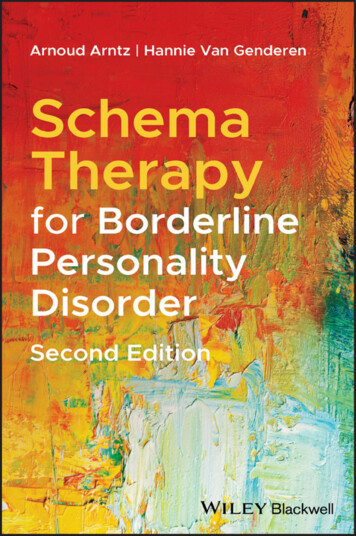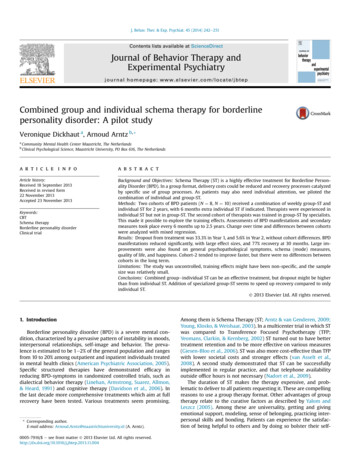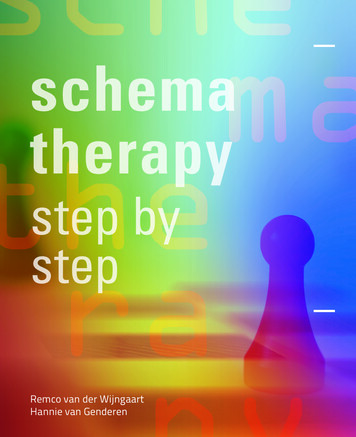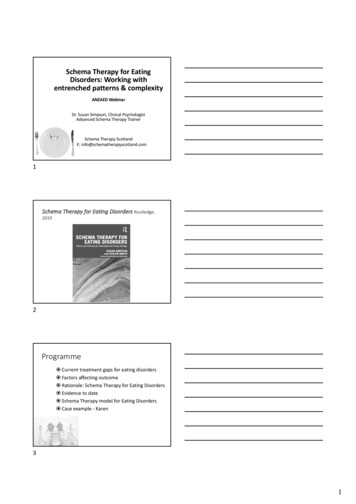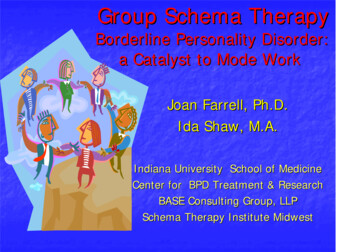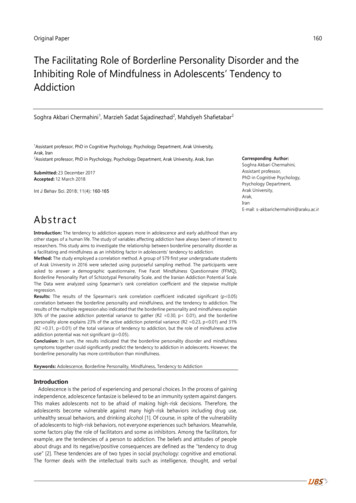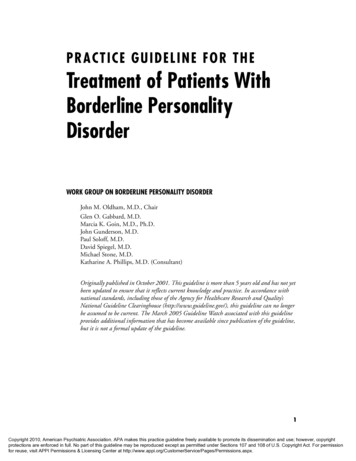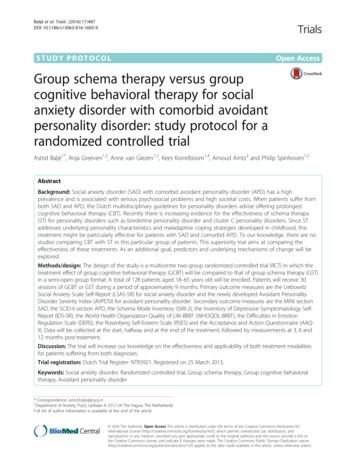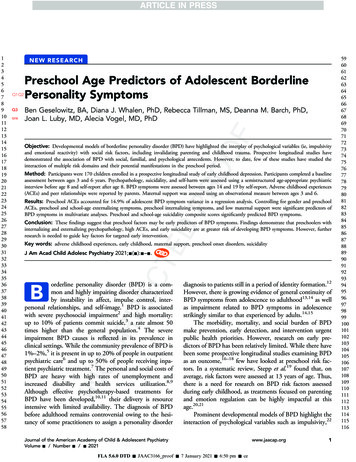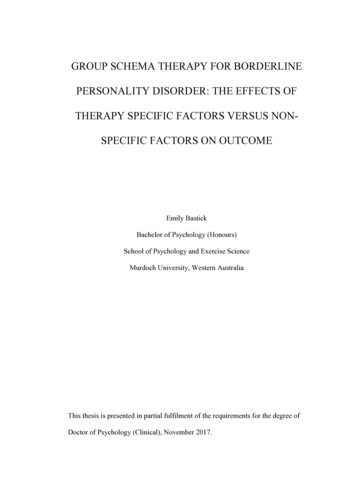
Transcription
GROUP SCHEMA THERAPY FOR BORDERLINEPERSONALITY DISORDER: THE EFFECTS OFTHERAPY SPECIFIC FACTORS VERSUS NONSPECIFIC FACTORS ON OUTCOMEEmily BastickBachelor of Psychology (Honours)School of Psychology and Exercise ScienceMurdoch University, Western AustraliaThis thesis is presented in partial fulfilment of the requirements for the degree ofDoctor of Psychology (Clinical), November 2017.
GROUP SCHEMA THERAPY FOR BORDERLINE PERSONALITYDISORDERiDECLARATIONI declare that this thesis contains no material which has been accepted for theaward of any other degree in any other university and, to the best of myknowledge or belief, contains no material previously published or written byanother person, except when due reference is made in the text.This DPsych dissertation is a ‘Thesis by Publication’ and contains six chapters,with two of those chapters containing manuscripts for publication. The candidatehad the primary role in the research and was the principal contributor to eachpaper, appearing as first author on each respectively.Each of the other stated authors provided some input to the respective manuscriptto varying degrees. This included supervision, active contributions to theconceptualisation and design of the research, and expertise in relation to theanalyses and reporting results. As stated within each manuscript, activecontributions to data collection was provided by Suili Bot and Simone Verhagen.For Study One (Chapter 3), all authors were invited to suggest edits, and hadprovided final approval prior to submission. For Study Two (Chapter Five),authors four and five were invited to suggest edits.The Thesis by Publication conforms to the guidelines published by MurdochUniversity Graduate Research Office.Emily BastickNovember 2017
GROUP SCHEMA THERAPY FOR BORDERLINE PERSONALITYDISORDERiiDEDICATIONI dedicate this thesis to my late grandparents, Brian Daniels (14/02/1934 –05/10/2003) and Elsie Daniels (06/11/1934 – 26/08/2015). Your influence on mylife has been profound, and I only wish you were here to help me celebrate thisachievement. I know that you would both be so proud. I miss you both very much.
GROUP SCHEMA THERAPY FOR BORDERLINE PERSONALITYDISORDERiiiACKNOWLEDGEMENTSFirst and foremost, I wish to sincerely thank my supervisors Doctor ChristopherLee and Professor Arnoud Arntz for their unwavering guidance, patience andkindness throughout this project. I truly appreciate your enthusiasm, deep passionand expertise in this field of work. I will be forever grateful to you.I wish to specially acknowledge Suili Bot and Simone Verhagen who spent manydays and nights watching and rating tapes with me. It was not an easy task but younever once complained. Your support has been incredible.I also extend this warm thank you to Joan Farrell, Gerhard Zarbock, and the manyothers who contributed to this research. I have learnt a great deal from yourknowledge and I am extremely lucky to have worked with you all.To all of the participants and therapists who made this project possible, I extendmy sincerest gratitude. I truly appreciate courage and effort it would have taken toparticipate in this study. I hope that you all continue to grow and flourish.To my loyal friends, thank you for all of your continued support over the yearsdespite me not being around as much as I would have liked. I have alwayspromised you that one day it will be over and you will have me back, and thattime is now. I will make it up to you all!Last but certainly not least, thank you to my dearest husband, my wonderfulfamily, and my dog, Nico. Although I sure have taken my time getting thisfinished, you never once doubted that I would get there in the end. I have been
GROUP SCHEMA THERAPY FOR BORDERLINE PERSONALITYDISORDERivtruly fortunate to have you all by my side throughout this journey (particularlyyou Nico for keeping my feet warm). I hope I have made you all proud. Mum anddad, there is no doubt that I owe this achievement to you. You have provided mewith everything I have ever wanted or needed in life and for that I will be forevergrateful.
GROUP SCHEMA THERAPY FOR BORDERLINE PERSONALITYDISORDERvABSTRACTThe conclusions from initial research on group schema therapy (GST) are that it isa promising treatment for borderline personality disorder (BPD). The overarchingaim of this research was to identify whether the unique aspects (or specificfactors) of GST effect positive change for patients with BPD. It was hypothesisedthat both treatment fidelity and group cohesion are important factors ininfluencing and predicting outcomes in GST for BPD.With the aim in mind, Study One sought refine and evaluate a fidelity measure forGST, the Group Schema Therapy Rating Scale - Revised (GSTRS-R). Followinga pilot study on an initial version of the scale, items were revised and guidelineswere modified in order to improve the reliability of the scale. Participantsincluded four therapists and 16 patients across two Australian GST groups.Students highly experienced with the scale rated 10 video recorded GST therapysessions using the GSTRS-R in addition to a group cohesion measure, the HarvardCommunity Health Plan Group Cohesiveness Scale – II (GCS-II). The resultingGSTRS-R was found to have excellent internal consistency, substantial inter-raterreliability, and adequate discriminate validity, evidenced by a weak positivecorrelation with the GCS-II.Study Two utilised the GSTRS-R to examine the relative contributions of specifictreatment factors related to schema therapy and non-specific factors (groupcohesion) on the treatment outcome of GST for BPD. Participants included 30therapists and 122 patients across 15 GST groups within three countries. Specific
GROUP SCHEMA THERAPY FOR BORDERLINE PERSONALITYDISORDERvitreatment factors were assessed using GSTRS-R and group cohesion via the GCSII. There was a significant, moderate positive correlation between treatmentfidelity (therapist competence) and group cohesion within the GST groups. Bettertherapist competence was associated with higher participant retention, with onetherapy delivery format having significantly better treatment retention than theother. Neither therapist competence nor group cohesion were found to account fora significant amount of variance in change scores (reduction in BPD symptoms).Thus there appears to be unique aspects of schema therapy that improves retentionabove common therapy factors such as group cohesion. The limitations andclinical implications of both studies are discussed.
GROUP SCHEMA THERAPY FOR BORDERLINE PERSONALITYDISORDERviiTABLE OF iABSTRACTvTABLE OF CONTENTSviiLIST OF TABLESxiLIST OF FIGURESxiiiCHAPTER 1: GENERAL OVERVIEW1Epidemiology of Borderline Personality Disorder .1Prevalence .1Comorbidities.2The Impact of Borderline Personality Disorder on Social Functioning .3Risk of suicide and self-harm .3Economic cost .4Limitations of Existing Treatment Modalities .6Pharmacological treatment .6Psychological interventions for BPD .7Schema Therapy for BPD .9The efficacy of schema therapy for BPD.15Group Schema Therapy for BPD .16Non-Specific Factors in Group Therapy .18Specific Factors in Therapy .20Interplay Between Specific and Non-Specific Factors .23CHAPTER 2: FIDELITY MEASURES FOR GST25The Group Schema Therapy Rating Scale (GSTRS) .25CHAPTER 3: STUDY ONE: REFINEMENT AND PSYCHOMETRICEVALUATION OF THE GSTRS-R28Abstract .30Introduction .31Group schema therapy for borderline personality disorder .31
GROUP SCHEMA THERAPY FOR BORDERLINE PERSONALITYDISORDERviiiAims and hypotheses .33Method .34Participants.34Raters .35Procedure .35Development of the GSTRS .35Tape selection .42Companion measure .43The GCS-II (Soldz et al., 1987) .43Statistical analyses .44Internal consistency. .45Inter-rater reliability of the GSTRS-R. .45Validity of the GSTRS-R.46Results .46Reliability.46Internal consistency. .46Inter-rater reliability.48Discriminant validity .49Discussion .49Limitations .51Application of the GSTRS-R .53Conclusions .54Acknowledgements .54Ethical Statements .55Conflict of Interests.55Financial Support .55References .56CHAPTER 4: BRIDGE61CHAPTER 5: STUDY TWO: GROUP SCHEMA THERAPY FORBORDERLINE PERSONALITY DISORDER: THE EFFECTS OF THERAPYSPECIFIC VERSUS NON-SPECIFIC FACTORS ON OUTCOME63Abstract .64
ixGROUP SCHEMA THERAPY FOR BORDERLINE PERSONALITYDISORDERIntroduction .66Method .73Participants.73Patients .73Therapists .73Group schema therapy treatment .74Measures .75Fidelity .75Group cohesion .76Raters and procedures .78Tape selection .78Statistical analyses .79Results .81Discussion .88Acknowledgements .92Ethical Statements .92Conflict of Interests.92Financial Support .92References .93CHAPTER 6: GENERAL DISCUSSION102REFERENCES107APPENDICES129Appendix A: The DSM-5 diagnostic criteria for BPD .129Appendix B: The GSTRS coding guidelines .132Appendix C: The Group Schema Therapy Rating Scale (GSTRS) .142Appendix D: Inclusion and exclusion criteria for the randomised control trialWetzelaer et al. (2014) .150Appendix E: The Group Schema Therapy Rating Scale – Revised (GSTRS-R) 151Appendix F: The GSTRS-R coding guidelines .165Appendix G: The GSTRS-R specific scale coding guidelines .175Appendix H: The Harvard Community Health Plan Group Cohesiveness Scale Version II guidelines .180
GROUP SCHEMA THERAPY FOR BORDERLINE PERSONALITYDISORDERxAppendix I: The Harvard Community Health Plan Group Cohesiveness Scale Version II scoresheet.189
xiGROUP SCHEMA THERAPY FOR BORDERLINE PERSONALITYDISORDERLIST OF TABLESCHAPTER 1Table 1.Early Maladaptive Schemas (EMS) with Associated SchemaDomains. 11Table 2.Schema Modes. 12CHAPTER 3Table 1.Revision of GSTRS General scale items. 38Table 2.Item-Total Statistics and Standard Deviations for the CompetenceRatings for the GSTRS-R General Subscale. 47Table 3.Item-Total Statistics and Standard Deviations for the GCS-II. 48CHAPTER 5Table 1.cBPDSI C: Descriptive Statistics and Correlation Matrix. 82Table 2.Estimates of Fixed Effects for GSTRS-R with DependentVariable ‘BPDSI Change Scores for Participants who CompletedTherapy (cBPDSI C)’. 83Table 3.Estimates of Fixed Effects for GCS-II with Dependent Variable‘BPDSI Change Scores for Participants who Completed Therapy(cBPDSI C)’. 83Table 4.cBPDSI I: Descriptive Statistics and Correlation Matrix.84
xiiGROUP SCHEMA THERAPY FOR BORDERLINE PERSONALITYDISORDERTable 5.Estimates of Fixed Effects for GSTRS-R with DependentVariable ‘BPDSI Change Scores for Participants who InitiatedTherapy (cBPDSI I)’.Table 6.85Estimates of Fixed Effects for GCS-II with Dependent Variable‘BPDSI Change Scores for Participants who Initiated Therapy(cBPDSI I)’. 85Table 7.Retention: Descriptive Statistics and Correlation Matrix. 86Table 8.Estimates of Fixed Effects for GSTRS-R with DependentVariable ‘Participants Remaining in Therapy at 18 Months(Retention)’. 87Table 9.Estimates of Fixed Effects for GCS-II with Dependent s(Retention)’.87
GROUP SCHEMA THERAPY FOR BORDERLINE PERSONALITYDISORDERLIST OF FIGURESCHAPTER 3Figure 1.Example of a Guideline from the Specific Subscale. 41Figure 2.Example of General Subscale Guidelines for Item 1. 42xiii
GROUP SCHEMA THERAPY FOR BORDERLINE PERSONALITYDISORDER1CHAPTER 1GENERAL OVERVIEWBorderline personality disorder (BPD) is a highly prevalent, disablingpsychological disorder, which is characterised by substantial distress and enduringdisruptions in functioning. Most patients with BPD experience chronic, pervasivepatterns of instability in interpersonal relationships, affect, behaviour, and selfidentity (American Psychiatric Association [APA], 2000). Clinical signs of thedisorder include chronic suicidal tendencies, repeated self-injury, addiction, andepisodes of depression, anxiety and impulsive aggression, which make thesepatients frequent users of mental-health resources (Lieb, Zanarini, Schmahl,Linehan, & Bohus, 2004). The diagnostic criteria for BPD in accordance with theAPA’s most recent psychiatric classification and diagnostic tool, the Diagnosticand Statistical Manual of Mental Disorders – Fifth Edition (DSM-5; APA, 2013)is presented in Appendix A.Epidemiology of Borderline Personality DisorderPrevalenceAlthough BPD is equally prevalent among men and women, women presentto services more often than men (APA, 1994; Coid, 2003; National Institute forHealth and Clinical Excellence [NICE], 2009), with the average number of BPDtraits being higher in adolescents and young adults (Cohen, Crawford, Johnson, &Kasen, 2005; Coid, Yang, Tyrer, Roberts, & Ullrich, 2006). Although there islimited Australian epidemiological data available, the community prevalence of
GROUP SCHEMA THERAPY FOR BORDERLINE PERSONALITYDISORDER2BPD in Australian adults is estimated at 1-2% (Jackson & Burgess, 2000).National estimates of community prevalence rates range between 0.7% in aBritish national community sample (Coid et al., 2006) and 5.9% in a US sample(Grant et al., 2008). A mid-range of 2-3% may not seem much, but those withBPD diagnoses make up about 20-30% of psychiatric inpatients and about 10% ofoutpatients receiving services (Korzekwa, Dell, Links, Thabane, & Webb, 2008;Torgersen, Kringlen, & Cramer, 2001; Widiger & Frances, 1989). Importantly 23% is considerably higher than the average lifetime prevalence of 0.3-1.5% forbipolar disorder (Weissman et al., 1996) and 0.4% for schizophrenia (Saha,Chant, Welham, & McGrath, 2005).ComorbiditiesUp to 96% of patients with BPD meet the criteria for concurrent Axis-I orAxis-II diagnoses (Grant et al., 2008; McGlashan et al., 2000; Zanarini et al.,1998). Comorbidities in BPD reflect a connection with both internalising andexternalising disorder symptoms and are considered the most relevant risk factorsfor suicide completion (Black, Blum, Pfohl, & Hale, 2004). Those withcomorbidities have an average of 4.1 lifetime Axis-I comorbidities, and 1.9lifetime Axis-II comorbidities (McGlashan et al., 2000). In particular, in terms ofAxis-I disorders, between 71% to 96.9% of BPD patients report lifetime clinicaldepression (McGlashan et al., 2000; Zanarini, Frandenburg, Hennen, & Silk,2004). This combination of BPD with depression increases patients’ subjectivelevels of distress and leads to a higher severity of suicide risk and a highfrequency of suicide attempts (Soloff, Lynch, Kelly, Malone, & Mann, 2000).Moreover, comorbid anxiety disorders are extremely common with 88% of BPD
GROUP SCHEMA THERAPY FOR BORDERLINE PERSONALITYDISORDER3patients having a diagnosable anxiety disorder; 47-56% meet criteria for posttraumatic stress disorder, and 34-48% meet criteria for panic disorder. In addition,alcohol and substance abuse or dependence has been reported by 50-66% ofpatients, predominantly in men, and eating disorders affect 29-53%,predominantly in women. In terms of Axis-II disorders, the most frequentlydiagnosed comorbid conditions are avoidant (43-47%), dependent (16-51%), andparanoid (14-30%) personality disorders (McGlashan et al., 2000; Zanarini et al.,1998).The Impact of Borderline Personality Disorder on Social FunctioningThe self-destructive and impulsive behaviours of people with BPD oftendisrupts family and work-life, social relationships, and long term planning (APA,1994; Skodol et al., 2002). Whilst families and friends may struggle to providesupport and care to these patients (Bauer, Döring, Schmidt, & Spießl, 2012;Dunne & Rogers, 2013), society bears the cost of more intensive utilisation ofhealth services (see Sansone, Songer, & Miller, 2005).Risk of suicide and self-harmBPD is the diagnosis most strongly associated with suicide among personswith a history of inpatient psychiatric treatment (Tidemalm, Elofsson, Stefansson,Waern, & Runeson, 2005). For this reason, BPD is often regarded as one of themost lethal psychiatric disorders and the most severe personality disorder. Inseveral studies, the percentage of patients with BPD that eventually committedsuicide (even after psychiatric treatment) was found to be between 2% and 17%,depending on the length of the follow-up (Oldham, 2006; Pompili, Girardi,
GROUP SCHEMA THERAPY FOR BORDERLINE PERSONALITYDISORDER4Ruberto, & Tatarelli, 2005; Zanarini, Frankenburg, Hennen, Reich, & Silk, 2006).In addition, more than 75% of individuals with BPD regularly engage in highlevels of non-suicidal self-injury (NSSI) including superficial cutting and burning(Linehan, Armstrong, Suarez, Allmon, & Heard, 1991; Stanley & Brodsky, 2005).Often BPD patients engage in NSSI for the purposes of distraction, angerexpression, and for reconnecting with their feelings (Brown, Comtois, & Linehan,2002).Economic costThe economic impact of BPD is significant, amounting to considerablefinancial costs to both the individual and the community. Frankenburg andZanarini (2004) showed that patients with active BPD have a higher risk ofsuffering from chronic physical conditions, making poor health-related lifestylechoices, and using costly forms of medical services than patients with remittedBPD.Sansone and colleagues (2005) found that, when compared with psychiatricinpatients with other diagnoses, inpatients with a diagnosis of BPD utilisedsignificantly higher levels of mental healthcare services. This included the numberof courses of psychotherapeutic treatment, the number of psychiatrists ever seen,the number of presentation times, and the length of hospital stay for mental healthproblems and/or substance abuse.An Australian preliminary cost benefit study of the effect of outpatientpsychotherapy in 30 patients with BPD concluded that there were net savings inthe year following treatment (Stevenson & Meares, 1999). The results indicated
GROUP SCHEMA THERAPY FOR BORDERLINE PERSONALITYDISORDER5that the cost of hospital admissions for the 30 patients the year before treatmentwas 684,346 (ranging between 0 and 143,756 per patient). On average, theycost the system 22,811 each. The overall cost significantly decreased in the yearpost therapy to 41,424 (ranging between 0 to 12,333 per patient), costing thesystem less than 1,380 each; an average decrease of 21,431 per patient. Equallyhigh values were found in the UK by Rendu, Moran, Patel, Knapp, and Mann(2002) who found that the average cost for primary care attenders with apersonality disorder diagnosis was estimated to be over 3094 in comparison to 1633 to those without. The costs incurred included healthcare costs andproductivity losses. More recently, van Asselt, Dirksen, Arntz, and Severens(2007) examined the societal cost of illness of BPD in the Netherlands and foundthat the total annual cost was 2.2 billion based on 1.1% prevalence rate in apopulation of approximately 12 million. It should be noted, however that only22% of this cost figure is health-related, the remaining costs consisted ofproductivity losses, costs to criminal justice, informal care and out-of-pocket costsas a result of their lifestyles (e.g., cigarettes, phone bills).As a consequence of their lifestyle, there tends to be many out-of-pocketcosts for BPD patients. Of the patients included in the trial by van Asselt andcolleagues (2007), almost 60% reported to have out-of-pocket costs associatedwith their BPD issues, totalling an annual average of 1395 per patient. Of thesepatients, 63% reported that the main costs were a result of extremely high phonebills, and excessive smoking, shopping, and binge eating. Other costs frequentlymentioned included the costs of bandaging self-inflicted wounds and excessivebuying of presents for others.
GROUP SCHEMA THERAPY FOR BORDERLINE PERSONALITYDISORDER6Furthermore, many patients with BPD tend to be chronically underemployed. The reasons for underemployment include relationship problems in theworkplace, and struggles with their sense of identity and life goals, causing themto drift from job to job. One Australian study by Stevenson, Meares, andD'Angelo (2005) reported that patients with BPD took an average of 3.5 monthsoff work per year before treatment, which significantly reduced to approximatelyone week off work per year post treatment. In the Netherlands, van Asselt andcolleagues (2007) found that BPD patients were absent from their jobs for anaverage of 218 hours per year (roughly 29 days, or 5 working weeks). Whencompared to actual wages, average costs to productivity due to absence from workwere 1320 per patient per year.Limitations of Existing Treatment ModalitiesPharmacological treatmentSeveral medications have demonstrated their effectiveness in treatingdifferent symptoms of BPD pathology, such as affective instability, dissociativestates, impulsivity, or cognitive perceptual symptoms (APA, 2001). Within theCochrane systematic review (Lieb, Völlm, Rücker, Timmer, & Stoffers, 2010), itwas recommended that mood stabilisers (such as valproate semisodium,topiramate, lamotrigine) are effective for affect regulation, instability, andaggressive/impulse-control symptoms. Also, the research suggests that atypicalantipsychotics (such as aripiprazole) have beneficial effects on the cognitiveperceptual aspect of BPD while first generation antipsychotics such as haloperidoland flupentixol reduces anger and suicidal behaviour respectively. These
GROUP SCHEMA THERAPY FOR BORDERLINE PERSONALITYDISORDER7medications may also facilitate treatment compliance and modifications oftemperament (Siever & Davis, 1991).At present, The Cochrane review suggests that there is no convincingevidence that any medication is an effective treatment for the overall severity ofBPD (Lieb et al., 2010; Stoffers et al., 2012). Nor have they been effective inaltering the nature or the course of the disorder (NICE, 2009). Thus, althoughcertain medications may be beneficial for specific symptom management,psychotherapy continues to be the primary, necessary method of treatment forBPD.Psychological interventions for BPDResearchers and practitioners have made substantial progress in developingeffective short-term psychological treatments for Axis-I disorders such as mood,anxiety, eating, somatoform, and substance use disorders (e.g., cognitivebehaviour therapy [CBT]). The primary focus of these treatments is to reducesymptoms, and to teach the patient skills and problem solving techniques.Although many patients are helped by these treatments, many others are not, forexample, those with underlying personality disorders such as BPD (Young,Klosko, & Weishaar, 2003).Although a many studies have reported CBT to be effective in treatingspecific symptoms of BPD (e.g., Cottraux et al., 2009; Davidson et al., 2006),others have considered patients with BPD ‘difficult to treat’ and they have notresponded well to traditional cognitive therapy techniques, or have relapsed (e.g.,Beck, Freeman, & Associates, 1990; Davidson, Tyrer, Norrie, Palmer, & Tyrer,
GROUP SCHEMA THERAPY FOR BORDERLINE PERSONALITYDISORDER82010; Mennin &
GROUP SCHEMA THERAPY FOR BORDERLINE PERSONALITY DISORDER: THE EFFECTS OF THERAPY SPECIFIC FACTORS VERSUS NON-SPECIFIC FACTORS ON OUTCOME Emily Bastick Bachelor of Psychology (Honours) School of Psychology and Exercise Science Murdoch University, Western Australia This thesis is presented in partial fulfilment of the requirements for the degree of
